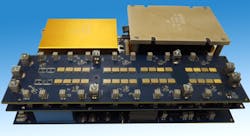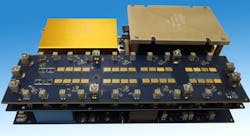As the falling price of gasoline helps to soften concerns about the impact of greenhouse gas emissions, researchers are staying focused on advancing electric cars and the charging infrastructure behind them. Recently, the Advanced Power Electronics Lab (APEL) at Kettering University partnered with HELLA, an automotive electronics company, to develop a compact vehicle charger that marks a big step forward in efficiency.
The researchers built what is known as a Level 2 charger, which plugs into a wall outlet and converts electricity into a form more suitable for electric cars. What sets apart the new charger is an efficiency of 97%, more than 3% over the average for these chargers. The charger used power switches based on gallium-nitride transistors, wide bandgap semiconductors that operate at higher voltages and temperatures than silicon. With these components, supplied by GaN Systems, the charger achieved a 2.6 kW per hour power density.
While Level 2 chargers typically have higher power densities than this new model, their efficiency has stalled around 94%. Even though they require special charging equipment, Level 2 chargers add about 10 to 20 miles of range per hour of charging time, according to the Alternate Fuels Data Center, the energy department's storehouse for electric vehicle data.
According to Dr. Kevin Bai, an associate professor of electrical engineering at Kettering University, the key to the charger’s efficiency is a special two-stage design. Unlike traditional three-stage versions, the new design allowed the researchers to make a lighter and more compact charger. Bai characterized the advance as a “game changer” in electric vehicle charging.
In a three-stage process, the charger converts ac grid voltage into dc voltage, inverts the dc into high-frequency ac, and then rectifying ac to dc again to charge the car’s battery. Bai says each stage of this process results in about a 2% power loss.
In addition to Level 2 chargers, there are also Level 1 chargers that add about 2 to 5 miles of range to an electric vehicle per hour of charging time. Also available are dc fast chargers, like the models used by Tesla Motors and Nissan, which can add roughly 50 to 70 miles of range in about 20 minutes, according to the Alternate Fuels Data Center. Tesla Superchargers can apparently provide 170 miles of range in about a half hour, delivering up to 120 kW of dc power directly to the battery, according to the company's website.
The research between HELLA and Kettering University began last year, as the automobile industry prepared for a new wave of advances in electric vehicles. Earlier this year at the 2016 Consumer Electronics Show, automotive companies unveiled new long-range electric vehicles, like the 2017 Chevrolet Bolt, which the company claims can drive more than 200 miles on a single charge.
While advances in rechargeable batteries and design have made electric vehicles more competitive with traditional cars, the charging infrastructure has been the subject of equally intense research. In 2015, for instance, Bai worked with Derindere Motorlu Araclar (DMA), a Turkish automotive company based in Istanbul that is focused on developing electric vehicles. They developed a prototype three-phase 380-volt, 24 kW charger, a huge step over existing 3.3kW or 6.6kW on-board chargers.
About the Author
James Morra
Senior Editor
James Morra is the senior editor for Electronic Design, covering the semiconductor industry and new technology trends, with a focus on power electronics and power management. He also reports on the business behind electrical engineering, including the electronics supply chain. He joined Electronic Design in 2015 and is based in Chicago, Illinois.


